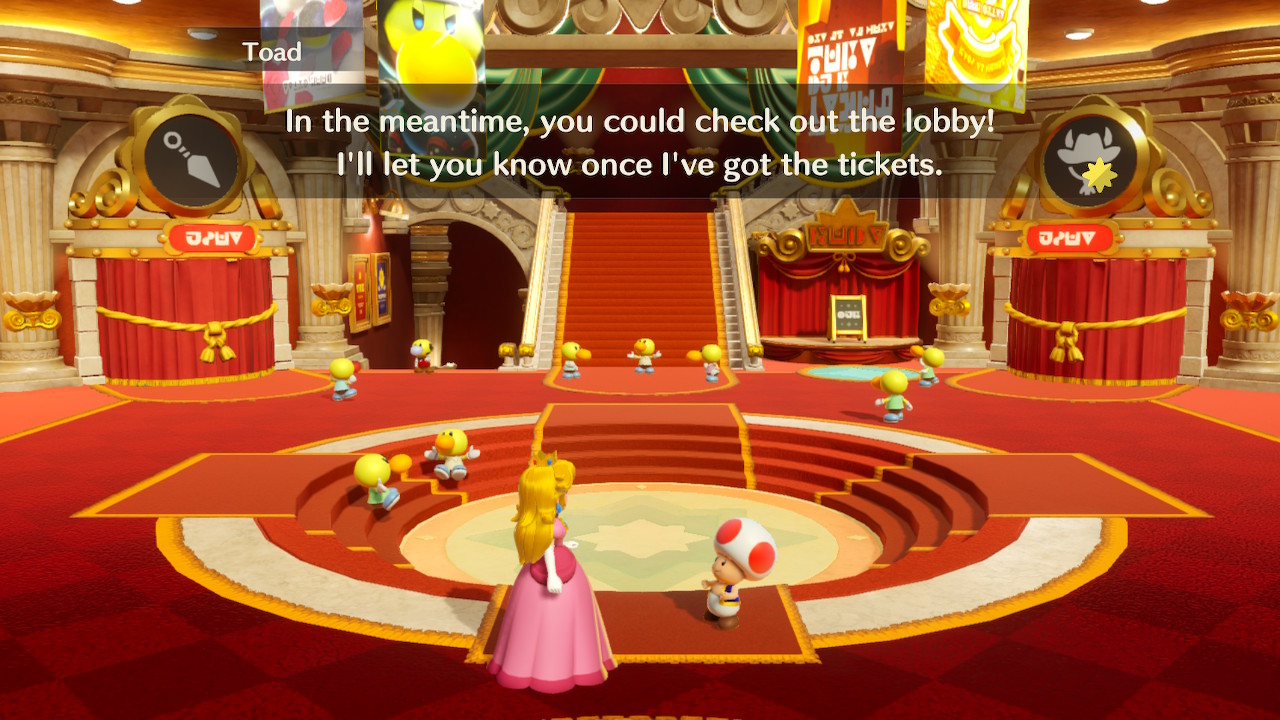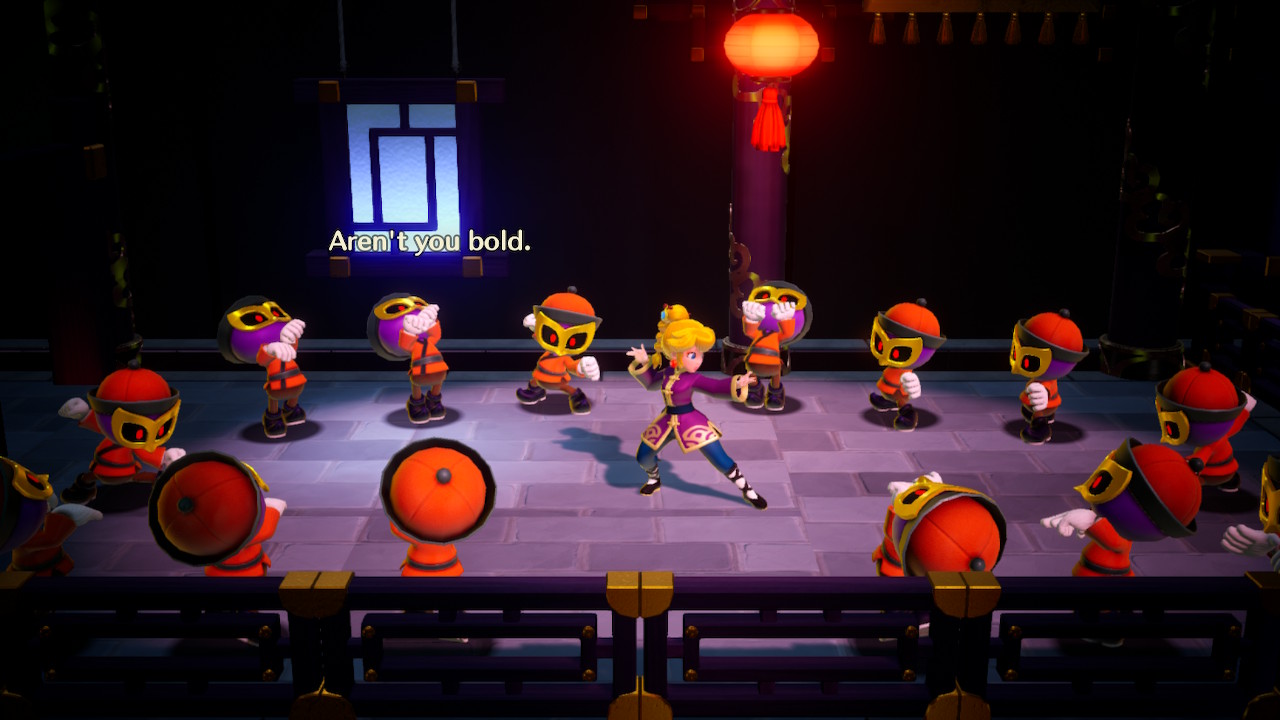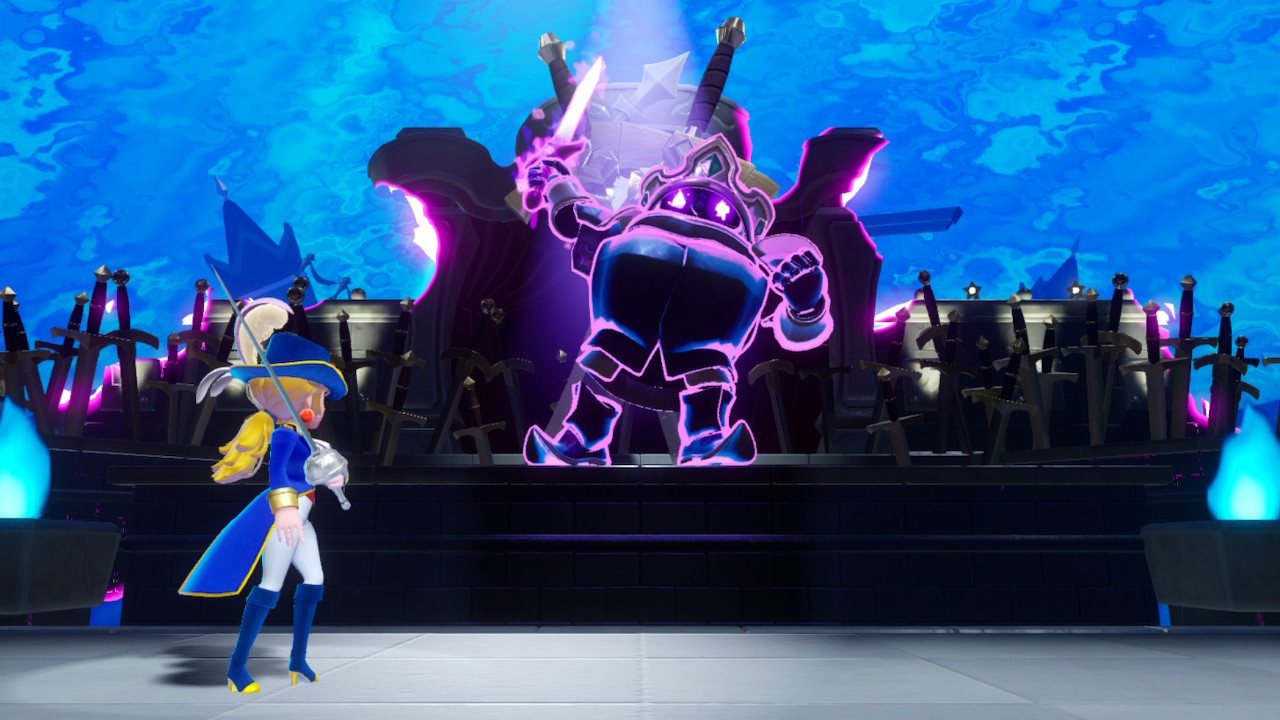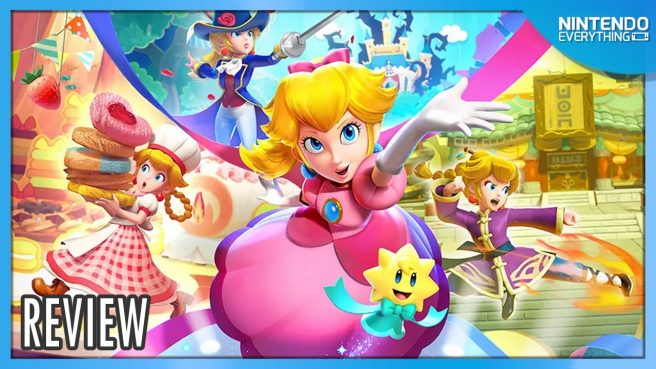[Review] Princess Peach: Showtime
System: Switch
Release date: March 22, 2024
Developer: Good Feel
Publisher: Nintendo
I’m not sure if Princess Peach has a rivalry with Kirby or something, but she’s picked up a shocking amount of skills in the nineteen years since her last solo game. In short order, Princess Peach: Showtime tasks the Mushroom Kingdom’s longstanding ruler with displaying all sorts of feats of talent, from figure skating to baking to lasso-wrangling – well, either that or she’s apparently a really good actress. Peach’s second-ever starring role is an approachable, varied, fast-paced adventure with plenty of memorable moments, and while it didn’t exactly leave me hoping for an encore, it’s refreshing playing a modern Mario-verse game that shines the spotlight on someone other than the plumber himself.
Princess Peach: Showtime is set within the surprisingly massive Sparkle Theater, a mega-complex that can apparently host twenty stage plays at once. Of course, as tradition has it, everything goes horribly wrong the moment the protagonist arrives – a sorceress named Grape decides that would be the perfect time to insert her minions into all the productions and mess them up, and on top of that, she’s captured the ten sparkle sprites who could really use some good, old-fashioned rescuing. What follows is a consistently entertaining experience that has Princess Peach taking the stage, donning different transformation abilities, and fighting off the members of the Sour Bunch that have rudely taken over the place.

One of the things that I really love about this game is how strongly the developers have embraced the “we’re in a theatre production” premise. Each stage really does give off that feeling, mostly thanks to the little details. Most things onstage, like buildings and foliage, look like the sort of wooden cutouts that you would actually see in a show; enemies have puppet strings that seem to guide them across the stage, and a spotlight follows Peach around as she explores. Sometimes you’ll even catch a glimpse of the stage curtains as Peach rounds a corner or enters a new part of the level. It’s excellent, and helps give Princess Peach: Showtime an identity that feels wholly its own.
While the game plays from a side-scrolling perspective, Princess Peach: Showtime is closer to a brawler (a very, very simple one) rather than a platformer – although there is a little bit of that scattered around, too. The main gameplay focus of Showtime is mastering each of the ten transformations; depending on which stage play she enters, Peach will don a new outfit that grants her abilities specific to that stage. Some are more focused on combat; others are more focused on puzzles or reflex-based challenges. They feel less like traditional power-ups, because they’re not optional and are tightly integrated into the design of each level. This approach definitely removes some player agency, in that there’s no real decision-making that needs to happen to, say, find the best route through the stage, which lowers the overall challenge. The benefit of this style of level design is that it really allows developer Good Feel to fill each stage with exciting set pieces and tailored gameplay challenges that keeps the game feeling fresh from start to finish. Each transformation is also only used three times, so they don’t wear out their welcome.

There are a few transformations that are more focused on combat. Swordfighter Peach lets the Princess slice and dice through hordes of foes, launch counterattacks and even attack upwards through platforms. Then there’s Kung-Fu Peach, which I don’t think feels drastically different in terms of the moment-to-moment battles, but differentiates itself at the end when the player has to defeat a Kung-Fu Master through well-timed blocks and parries. Those are perhaps the most technical of the transformations in-game, and really, they’re not all that technical to begin with – controls are simple, and most players will likely face no difficulty getting to the end. There are some other transformations that technically do include combat, but deemphasize it compared to other gameplay elements. For example, Cowgirl Peach wields a lasso she can use to pick up minions and objects and hurl them at each other, but the real focus of these stages is pulling off classic wild-west scenes, like chasing pursuers on a horse or sprinting across the top of a moving train.
One of the small things I love about Princess Peach: Showtime is that the layout of the Sparkle Theater gives players a little bit of choice about what they want to do next. Each floor of the theatre has four stages attached to it (except for the basement, which has ten) and once a new floor is unlocked, players can complete each stage on that floor in whatever order they choose. I liked this approach because I could flip between the relaxed and fast-paced stages as I chose, depending on what I was in the mood for.
On that note, I was actually quite surprised at how much I enjoyed the less action-focused transformations. The variety of gameplay in Princess Peach: Showtime is impressive, and that’s partially because not every level is about beating up baddies. The stages featuring Patisserie Peach, for example, focus on baking-centric minigames like decorating cakes under time pressure and baking cookies in a bake-off type scenario, and I found them really fun despite probably not being the target audience for them. For those who enjoy stealth, Ninja Peach’s levels will likely be a highlight – while its very simple, there’s something satisfying about avoiding the line of sight of guards by slinking through foliage or sliding along a wall before attacking from behind.

I think my favorite transformation in the game, all things considered, were Detective Peach’s stages. Here, you spend time poking and prodding through environments doing some very light sleuthing, like trying to solve an art heist in a museum. Again, the logic puzzles here aren’t very tricky, but that’s not the point; it’s just inherently charming watching Peach use her “Strike of Intuition” to accuse someone of being a suspect in a crime, or spinning some statues around to open a path to a collectible. There’s a lot of novelty in seeing Peach doing something other than being a non-character for once, and while that novelty does eventually fade, for most of Showtime’s runtime I was having a ball just embracing the silliness of everything.
The narrative in Princess Peach: Showtime is extremely light, because beyond the main premise of trying to stop Grape, each stage has its own self-contained story. It mostly boils down to “Oh no, the bad guys are messing up THIS play TOO” and going to rescue someone or retrieve something that was stolen. It would be nice if there was little bit more going on, but I did find the new characters quite charming. Stella is Peach’s main companion for this game, and she’s a little floating star ribbon thing – not a particularly deep character by any stretch, but cute and very invested in the adventure. It’s the Theets – the little yellow fellows that can be spotted running all around the place – who are the real stars of the show. They’re positioned as the staff, actors, and guests attending the Sparke Theatre, and they can have some pretty amusing dialogue here and there, but I mostly just enjoyed seeing them playing a role in the various productions.

Stages have a decent amount of replayabity too, depending on how thorough you are. Each level has somewhere in the vicinity of 7-10 Sparkle Gems the player can collect. Sometimes, they’re just floating in plain sight, but most of the time they need to be found – often they’re hidden in backstage challenge rooms, or behind a piece of scenery. In reflex-based stages like those featuring Cowgirl Peach, a well-timed jump might be your only chance to grab one before passing it by. They’re also awarded based on performance in certain minigames, and the criteria for some of these can be surprisingly strict; when playing as Figure Skater Peach, for example, the player has to hit certain jumps and spins as they skate around the ice, and missing even one might mean not earning the gem for that segment. It’s not possible to backtrack very far in a stage in Princess Peach: Showtime, which means if the player misses a gem, the only way to attempt it again is by replaying the whole stage – and some of these stages are a decent length. I definitely missed quite a few my first time running through a level, and so I expect that players who enjoy hunting down collectibles will get quite a bit more playtime.
A big highlight of Showtime for me was the bosses, which I found to generally be quite creative and interesting. Sometimes, even mainline Mario games struggle with this – I grew tired of fighting the Broodals in Super Mario Odyssey, for example, because they all looked and felt so similar and were able to be taken down in just a few hits. I don’t want to spoil all of them because they’re so exciting to encounter for the first time, but each one has its own gameplay loop attached and they all feel quite dramatic compared with the lighter, low-stakes fare of the main stages. My favorite was Purrjector Cat, whose unsettling appearance and less predictable attack patterns result in a very fun battle.
The animations in Princess Peach: Showtime are excellent – I loved the way Peach would slide down the railing of the stairs when descending between the floors of the theatre, or the way she would do a little two-step dance to the beat of the music while idling in the Patisserie stages. The game generally looks great across the board, although it can look a little soft in handheld mode from time to time when the action is zoomed-out. The frame rate isn’t always great – it tends to be mostly okay during gameplay, but almost always drops during in-engine cutscenes and transformations, and in the hub area. I didn’t find it so egregious that it took away from the fun of playing the game, but it definitely doesn’t share the high level of across-the-board polish that players have come to expect from a major Nintendo release – a shame, since the Switch is capable of more.
The Verdict

Princess Peach: Showtime is a delightful little experiment from Nintendo, and while Peach’s second solo game may not have the scope or challenge of something like a mainline Mario game, it won me over thanks to its varied gameplay, creative artistic direction, and sheer charm. The various transformations Peach utilizes are distinct, and make up for the light platforming by focusing on constantly shaking up moment-to-moment gameplay and embracing the theatre setting. Solid replayability, great bosses, and beautiful animation help elevate what could have been a simple kid-friendly game into something that should appeal to Mushroom Kingdom fans of all ages. Hopefully this release represents just the beginning of a new era for Nintendo’s less-featured characters – I’m glad they took a chance on this new idea, and hope they’ll do it again soon.
Princess Peach: Showtime copy provided by the publisher for the purposes of this review.
